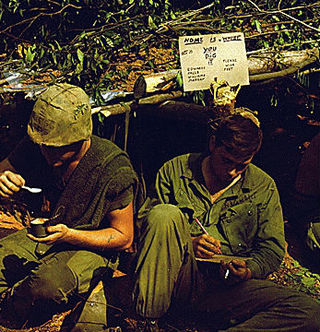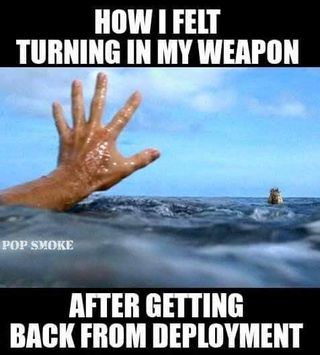Humor
An Awful Joke Can Feel Pretty Good
Military members often turn to "gallows humor" to handle the stress of the job.
Posted May 10, 2018 Reviewed by Kaja Perina
It was that joke at the deepest part of the blackest kernel of fear, and you could die laughing. —Michael Herr, Dispatches
We’ve all heard phrases like: we laugh lest we cry; laughter is the best medicine; nothing can withstand the assault of laughter. Laughter has long been considered therapeutic and studies demonstrate that in the face of stress, comedy is a more effective coping strategy than seriousness. And if you’ve ever spent any time around the military, you’ve likely heard a joke or two. Okay, more than two.

Culturally, military members turn often to "gallows humor" or "black humor" to handle the stress of the job. Irreverent reverence is standard operating procedure and the most colorful black humor arises in the direst situations.
Black humor is best described as the kind of humor that treats threatening or disturbing subjects (i.e. death, combat, disease, deformity) with levity or amusement. This humor is typically employed to somehow convey the absurdity, illogicality, or helplessness of a situation. In essence, it juxtaposes a morbid element with a farcical one.
The original term, galgenhumor, is Germanic and has historical links to the persecuted and doomed. As such, gallows humor possesses a rebellious, subversive quality not present in other humor styles (i.e., affiliative, self-enhancing, aggressive, and self-defeating ones).
Broadly speaking, humor capitalizes on categories, thoughts, or experiences which have been previously organized into frames or scaffolds in our minds. These existing frames are then recalled or evoked by sights, sounds, or impressions.

For example, take the average meme. Typically, a photo meant to convey an emotion/expression/feeling is overlaid with a quote not originally associated with the picture itself. The processing of the meme’s humor is the result of frame blending. It requires the recruitment and integration of background knowledge, like the quote’s origin, into the picture. It is the blurring of these two distinct scenarios, or frames, which results in the hilarious hybrid.
As it applies to dark humor, take a look at the below excerpt from House to House, a memoir about the intense fighting during the first battle of Fallujah: “As we start to clear another block of houses, I spot an insurgent lying against a wall. I shoot him, and my bullets pop his bloated stomach like a balloon. The corpse lets out a long farting sound as the air inside it escapes.” The author then turns to his squad mate and says, “Excuse me. I’ve been fighting that back since Baghdad.” In this gruesome scene, the author engages in stereotypical flatulence humor in the face of a potentially traumatic experience.
Humor moderates stress. Creating a humorous narrative about a stressful situation can result in reduced physiological stress response, less emotional distress, and lower negative emotions. Black humor in particular typically takes a negative event or experience and reconsiders it from a less threatening point of view. This allows the person who experiences the negative event to look directly at what is painful but see and interpret it in a less harmful or threatening way. The process of reassessing stressful situations in order change the trajectory of an emotional response is called cognitive reappraisal. In the example above, rather than allowing himself to feel hopeless, disgusted, angry, scared, or any other negative emotion, the author used a joke to alter his emotional pathway.
Any guesses as to what the most adaptive emotion regulation strategy is? Cognitive reappraisal.
The act of laughing itself improves oxygen consumption, and its after-effects include slower heart rate and lower blood pressure due to changes in the body’s endocrine system. Moreover, the function of laughter potentially serves as a release of nervous energy—which is why people might laugh uncontrollably when enormously angry or grieving—and it promotes group cohesion. Literally, cracking up keeps you from cracking up.
There is, accordingly, space to use black humor in therapy. In a recent session with a former special operations soldier, he recounted a story about one of his many deployments. The mission of his unit was to eliminate a high value target and provide evidence of the successful killing of the person. One way of providing such evidence was to bring back the hands or fingers for biometric verification. After a particularly intense operation, my patient somehow forgot the presence of severed fingers in his kit and during an equipment inspection, they were discovered. Not surprisingly, he faced serious reprimand.
My response: “I can see you’re struggling with numerous feelings about the situation. On the one hand, you did your job well and felt you deserved recognition, and on the other, you understand you made a mistake and couldn’t deny the allegations because every finger pointed to you.”
While this might not work with everyone, here the humorous exchange created an atmosphere that allowed him to share other emotional memories with greater ease. It also demonstrated to him that I could “take it.” This eventually facilitated the integration of the experiences and humanized them in a new way.
Using black humor with military members or combat veterans is an opportunity to validate and accept their experience and humor preference. In war, humor was very likely used as a shield for survival and a tool for coping. During treatment, it can be the same.
“Gentlemen, why do you not laugh? With the fearful strain that is upon me day and night, if I did not laugh, I should die.” —Abraham Lincoln
References
Garrick, J., & Williams, M. B. (2014). The humor of trauma survivors: Its application in a therapeutic milieu. In Trauma Treatment Techniques (pp. 191-204). Routledge.
Kuiper, N. A. (2012). Humor and resiliency: Towards a process model of coping and growth. Europe’s Journal of Psychology, 8(3), 475-491.
Lehman, K. M., Burke, K. L., Martin, R., Sultan, J., & Czech, D. R. (2001). A reformulation of the moderating effects of productive humor. Humor–International Journal of Humor Research, 14(2), 131-161.
Samson, A. C., & Gross, J. J. (2012). Humour as emotion regulation: The differential consequences of negative versus positive humour. Cognition & emotion, 26(2), 375-384.
Willinger, U., Hergovich, A., Schmoeger, M., Deckert, M., Stoettner, S., Bunda, I., ... & Jaeckle, D. (2017). Cognitive and emotional demands of black humour processing: the role of intelligence, aggressiveness and mood. Cognitive processing, 18(2), 159-167.




